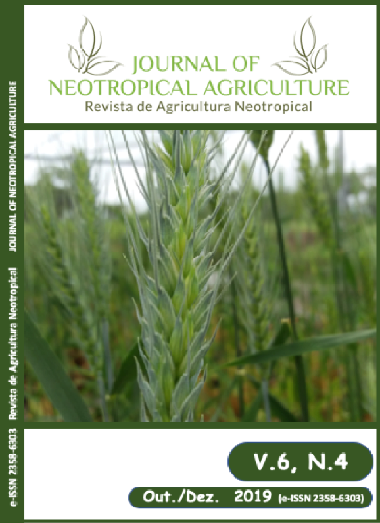CHANGES IN LAND USE IN MATO GROSSO DO SUL
DOI:
https://doi.org/10.32404/rean.v6i4.3827Abstract
Among the species cultivated in Mato Grosso do Sul, the area with soybeans is larger than that only for pasture cultivation. This work was developed in fourteen municipalities of the state. Based on information from the Brazilian Institute of Geography and Statistics (IBGE), the evolution of the area occupied by soybean, pasture and sugarcane in these municipalities was analysed. In particular, the area cultivated with soybeans has shown constant and significant growth. On the other hand, the pasture area has been continuously decreasing, especially in Ponta Porã, Maracaju and Rio Brilhante. The areas previously occupied with pastures are giving way to soy and sugarcane cultivation.
References
(I) Biosul, 2019. Mapa da bioenergia em Mato Grosso do Sul. http://biosulms.com.br/estatisticas/ (Acessado 30 de outubro 2019).
(II) Brasil, 2018. Ministério da Agricultura Pecuária e Abastecimento. Serviço de Inspeção Federal. Quantidade de abate estadual por ano/espécie: aves. Brasília, DF. http://sigsif.agricultura.gov.br/sigsif_cons/!ap_abate_estaduais_cons?p_select=SIM (Acessado 31 de outubro de 2019).
(III) Conab, 2019a. Acompanhamento da safra brasileira de grãos: safra 2018/19: sétimo levantamento, Brasília, DF, v. 6, n. 7, 115 p. https://www.conab.gov.br/info-agro/safras/graos (Acessado 3 de abril de 2019).
(IV) Conab, 2019b. Acompanhamento da safra brasileira: cana-de-açúcar: safra 2019/20: segundo levantamento. Brasília, DF, v. 6, n. 2. file:///C:/Users/silvia/Downloads/BoletimZCanaZ(28ZLevantamentoZ19-20.pdf (Acessado 30 de outubro de 2019).
(V) Contini, E., Gazzoni, D., Aragão, A., Mota, M., Marra, R., 2018. Complexo soja - caracterização e desafios tecnológicos. [Brasília, DF]: Embrapa, 35 p. (Série desafios do agronegócio brasileiro. Nota técnica, 1). https://www.embrapa.br/documents/10180/0/COMPLEXO+SOJA+-+Caracteriza%C3%A7%C3%A3o+e+Desafios+Tecnol%C3%B3gicos/709e1453-e409-4ef7-374c-4743ab3bdcd6 (Acessado 17 de abril de 2019).
(VI) Embrapa, 2018. Visão 2030: o futuro da agricultura brasileira. Brasília, DF, 212 p.
(VII) FIESP, 2018. Outlook Fiesp 2028: projeções para o agronegócio brasileiro. São Paulo: FIESP, 86 p. http://hotsite.fiesp.com.br/outlookbrasil/2028/files/assets/basic-html/page-4.html (Acessado 28 de agosto de 2019).
(VIII) Franchini, J.C., Vallini, C.L., Balbinot Junior, A.A., Debiasi, H., Watanabe, R.H., 2016. Integração lavoura-pecuária em solo arenoso e clima quente: duas décadas de experiência. Londrina: Embrapa Soja, 12 p. (Embrapa Soja. Circular técnica, 118).
(IX) Gazzoni, D.L., 2013. A. sustentabilidade da soja no contexto do agronegócio brasileiro e mundial. Londrina: Embrapa Soja, 50 p. (Embrapa Soja. Documentos, 344).
(X) Hirakuri, M.H., 2017. Avaliação econômica da produção de soja nos Estados do Paraná e Rio Grande do Sul na safra 2016/17. Londrina: Embrapa Soja, 14 p. (Embrapa Soja. Circular técnica, 126).
(XI) Hirakuri, M.H., Lazzaroto, J.J., 2014. O agronegócio da soja nos contextos mundial e brasileiro. Londrina: Embrapa Soja, 70 p. (Embrapa Soja. Documentos, 349).
(XII) IBGE, 1998. Censo agropecuário 1995-1996. Número 23 - Mato Grosso do Sul. Tabela 67: Utilização das terras, segundo Mesorregiões, Microrregiões e Municípios. Rio de Janeiro.
(XIII) IBGE, 2019a. Sistema IBGE de Recuperação Automática. Banco de Dados Agregados. Tabela 1612: área plantada, área colhida, quantidade produzida, rendimento médio e valor da produção das lavouras temporárias. [Rio de Janeiro, 2019]. https://sidra.ibge.gov.br/tabela/1612 (Acessado 07 de fevereiro de 2019).
(XIV) IBGE, 2019b. Sistema IBGE de Recuperação Automática. Banco de Dados Agregados. Tabela 6615: número de estabelecimentos agropecuários, quantidade produzida e área colhida, por produtos da lavoura temporária: resultados preliminares 2017. [Rio de Janeiro, 2019]. https://sidra. ibge.gov.br/tabela/6615 (Acessado 22 de fevereiro de 2019).
(XV) Nogueira, M.P., 2019. A evolução da área de pastagens no Brasil. http://www.rallydapecuaria.com.br/index.php/node/1366 (Acessado 30 de outubro de 2019).
(XVI) O Futuro é agro: 2018-2030, 2018. [Brasília, DF]: CNA: Conselho do Agro, 135 p. https://www.cnabrasil.org.br/documentos-tecnicos/o-futuro-e-agro-plano-de-trabalho-2018-a-2030 (Acessado 17 de abril de 2019).
(XVII) Salton, J.C., Arantes, M., Zimmer, A.H., Richetti, A., Tomazi, M., Kruker. J.M., Mercante, F.M., Kichlel, A.N., 2017. Sistema São Mateus: viabilidade técnica- econômica do sistema integrado de produção no Bolsão Sul-Mato-Grossense. Dourados: Embrapa Agropecuária Oeste, 11 p. (Embrapa Agropecuária Oeste. Circular técnica, 40).
(XVIII) Semagro, 2018. Políticas públicas favorecem troca da área de pecuária por lavoura sem reduzir rebanho e sem pressionar meio ambiente. http://www.semagro.ms.gov.br/ibge-confirma-ms-foi-unico-estado-produtor-a-aumentar-area-plantada-em-2018/ (Acessado 30 de outubro de 2019).
(XIX) Souza, G.S., Alves, E., Gomes, E.G., Gazzola, R., Marra, R., 2007. Substituição de culturas: uma abordagem empírica envolvendo cana-de-açúcar, soja, carne bovina e milho. Revista de Política Agrícola, 16(2), 5-13.
(XX) Streck, I.L., Pires, M.A.B., Silva, V.R., Luz, F.B., Rieth, L.G., Goergen, N., 2018. Diagnóstico da mudança de uso da terra para produção de soja no Rio Grande do Sul. Revista Plantio Direto & Tecnologia Agrícola, 28(11), 13-18.
(XXI) Vieira Filho, J.E.R., 2018. Efeito poupa-terra e ganhos de produção no setor agropecuário brasileiro. Brasília, DF: IPEA, 41 p. (IPEA. Texto para discussão, 2386).
Downloads
Published
How to Cite
Issue
Section
License
The authors retain the rights to the manuscripts and, therefore, are free to share, copy, distribute, perform and publicly communicate the work under the following conditions:
Acknowledge work credits in the manner specified by the author or licensor (but not in a way that suggests that you have their support or that they support their use of their work).
REVISTA DE AGRICULTURA NEOTROPICAL (ISSN 2358-6303) is under license https://creativecommons.org/licenses/by/4.0/
The State University of Mato Grosso do Sul, Sustainable Development Center of Bolsão Sul-Mato-grossense (CEDESU), of the University Unit of Cassilândia (UUC), preserves the patrimonial rights (copyright) of the published works and favors and allows their reuse under the license as mentioned above.
------------
The journal reserves the right to make normative, orthographic, and grammatical alterations in the originals, to maintain the cult standard of the language, respecting, however, the style of the authors.
Final proofs will be sent to the authors.
Published works become the property of the journal. The opinions expressed by the authors of the manuscripts are their sole responsibility.

